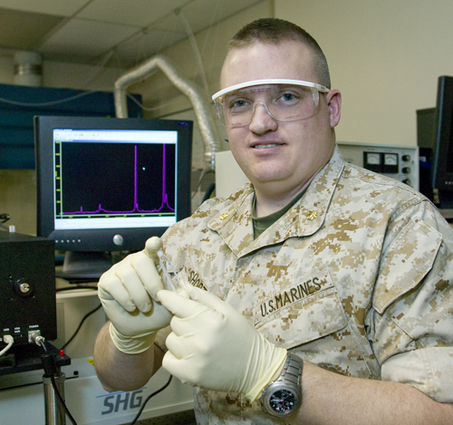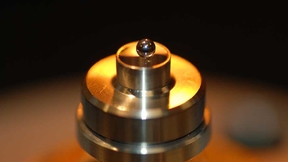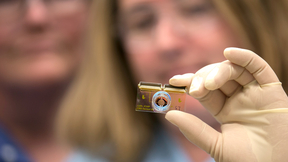Forensics helps NPS officer detect his niche
 (Download Image)
Photo by Jacqueline McBride/NEWSLINE Bill Short
(Download Image)
Photo by Jacqueline McBride/NEWSLINE Bill Short
Major Bill Short's time at the Laboratory may turn out to be brief, but he believes it just might stand out as one of the most valuable experiences of his career.
With 20 years of service in the U.S. Marine Corps, Short enrolled in the Naval Postgraduate School (NPS) in Monterey. There he learned about an LLNL research opportunity in the area of standoff detection of explosives. In January, he joined Chance Carter, a research scientist in the Physics Division of the Physical and Life Sciences Directorate, to conduct studies that hold promise for major advances in the forensic analysis of explosives and the detection of improvised explosive devices (IEDs) and land mines.
"There are very few techniques like this," Short explained. "This is literally the 'holy grail' of such applications, and with a lot of potential."
Short, who hails from Baltimore, Md., has a bachelor's degree in chemistry from Towson University and a master's degree in analytical chemistry from the Illinois Institute of Technology. Prior to his studies at NPS and his arrival at the Lab, Short worked in the Office of Naval Research, where he managed a wide variety of programs, including force protection. In June, he will graduate from the NPS.
"The resources here at the Lab are unsurpassed," Short said. "And, my work here matches my skill set and interests. It's been a perfect fit for me."
The research, done in collaboration with scientists at the University of South Carolina and the University of Hawaii, is six years in the making, and could lead to a detection capability at standoff distances using visible and ultraviolet light. A method of this kind — to detect possible explosives of terrorists or assassins from a safe distance — is rare.
The project utilizes "basic science" applications involving Raman technology in high explosives materials to understand fundamental science issues, spectral differences in high explosives material, and to determine if signal enhancements are possible.
Carter points out that there are still challenges ahead in the development. "It could take several years before we see the application ready for use in the military arena," he said, also noting there is much competition in the field.
For Carter, having Short on his team and serving as his mentor, has been a perfect fit and nothing but positive. "Teaming with the NPS to acquire students to work at the Lab is very beneficial," Carter said. "It has been an excellent experience. With Bill's help, I have gained some new contacts. And, we expect several peer-reviewed publications to emerge from his work.
"The key components of a productive mentor-student relationship are for the mentor to be available, the resources to be at hand, and the project, even if brief, to be focused and well defined for the student," Carter said.
Carter believes that Short's work ethic also has contributed greatly to his success in that many aspects of his work ethic are well aligned with the Lab's 'A-List.' For example, Short is passionate about protecting the nation's security, working with the highest integrity and supporting a collaborative workplace.
Carter added that the standoff detection project is funded through the Laboratory Directed Research & Development (LDRD) program, the principal source of internal R&D funding at LLNL. "The LDRD funding has allowed us to pursue a very innovative and technically risky approach."
The NPS-LLNL collaboration represented in Short's research is one of many ongoing interactions between the two institutions. Since 1998, LLNL and the NPS have worked together in a series of exchanges and collaborations focused on mutual research interests related to national security. In 2004, a memorandum of understanding was initiated to formalize the interactions.
Contact
Linda Lucchetti[email protected]
Tags
Laboratory Directed Research and DevelopmentFeatured Articles







